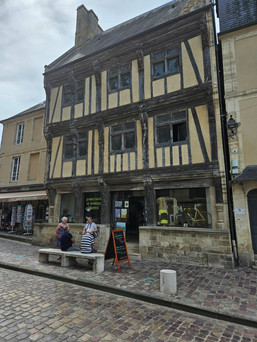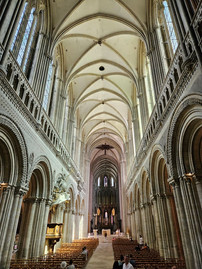3 days in Normandy
- Aug 5
- 7 min read

After an unforgettable week in Brittany with our friends, we're off to Normandy for three days for a trip filled with history, with a capital H. For years, Jeff has wanted to visit the D-Day landing beaches, key sites of the Second World War. Well, now it's done!
Our itinerary
Day 1 : Omaha Beach
Day 2 : Utah Beach
Day 3 : Juno Beach
Day 4 : Departure to Paris
Our favorites
History
This is the first time we've taken a trip that arouses so many emotions.
The history of D-Day is omnipresent in every corner of the country. It's the region's main tourist attraction. Everything is done to preserve the memory of these events, which had a direct impact on the end of the Second World War.
It's one thing to learn about history in school or watch films about the events of this war. But when you find yourself in the places where all these events took place, see period footage, and discover survivors' testimonies, it makes you realize what these young people went through and the sacrifices they made for future generations.
Our travels
Car
We rented a car at Nantes airport and returned it to Saint-Germain-en-Laye in the Paris region at the end of our stay in France.
Our accommodation
We booked a room at the domaine du Grand Caugy. Located very close to Bayeux, this hotel is very quiet and peaceful. The staff and service are impeccable. We loved it. We chose the hotel for its location, as the town of Bayeux is inland, not far from all the D-Day landing beaches.
Day 1
We leave our gîte in Brittany (and our friends from FA'QUE!) in the morning to go some 200km away, to Omaha Beach. Quite a change of scenery...
We started at what was undoubtedly the most famous of the D-Day beaches, Omaha Beach, nicknamed "Bloody Omaha" due to the heavy losses suffered by American troops during the initial assault of the Normandy landings.
On D-Day, June 6, 1944, the Allied forces staged the largest landing ever seen in modern military history. Under the code name Operation Neptune, more than 156,000 men took part in the operation by sea and air. 153,000 of them arrived by sea on the five Normandy beaches (Utah Beach, Omaha Beach, Sword Beach, Juno Beach, and Gold Beach) and at Pointe du Hoc.
From June 4th and 5th, German coastal communications and radar stations were destroyed, blinding the enemy and enabling sabotage and guerrilla operations by the French Resistance.
On June 6th at 12:05 a.m., the first American and British parachute drops began in Normandy.
Beginning at 4:30 a.m., a series of aerial and naval bombardments fell on the beaches.
At 6:30 a.m., the First American Division reached Utah Beach. Allied forces then attacked Omaha Beach at 6:45 a.m., Gold Beach at 7:30 a.m., Juno Beach at 7:35 a.m., and Sword Beach at 7:45 a.m.
Today, all these beaches are places of visit and remembrance, where visitors can remember history and honor the memory of the fallen soldiers. Each beach has its own memorial and museum. We decided to visit the one at Juno Beach, where the Canadian forces arrived.
The Normandy landings resulted in considerable human losses on both sides of the war (the Allies and the Germans), as well as among civilians. Here are some chilling statistics:
Allied losses:
June 6 (D-Day): Approximately 10,500 casualties, including dead, wounded, and missing.
Battle of Normandy (total): Approximately 209,670 casualties, including 37,000 dead.
American losses on D-Day: Approximately 6,000.
American losses on Omaha Beach on D-Day: Approximately 2,500.
German losses:
Total losses during the Battle of Normandy: Approximately 200,000, including killed and prisoners.https://maps.app.goo.gl/TH7RHpoABgpgn7BH8
Civilian casualties in Normandy:
Total civilian casualties in Normandy: Approximately 20,000.
Bombing of Le Havre: Approximately 1,770 civilians killed.
Bombing of Caen: Approximately 1,741 civilians killed.
Bombing of Rouen: Approximately 883 civilians killed.
Bombing of Saint-Lô: Approximately 400 civilians killed.
Bombing of Falaise: Approximately 350 civilians killed.
In every town and village in the region, there are monuments or signs that recount and commemorate this tragic yet liberating day.
After walking along Omaha Beach, we head to the American Cemetery, located just above Omaha Beach, in the French commune of Colleville-sur-Mer (Calvados).
9,388 people, including 307 unknown persons, four women, and one victim of the First World War, are buried in this 70-hectare cemetery. These people mainly died on the day of the Normandy landings or in the following weeks.
We spend our first evening in Bayeux, a city that is astonishing for its beauty and history. Bayeux is a very ancient city, having been founded during the Gallo-Roman period, in the 1st century BC. The medieval historic center is made up of cobbled streets and half-timbered houses. It is also home to the Norman Gothic-style Notre-Dame Cathedral, which was for a long time the home of the famous Bayeux Tapestry.
This tapestry retraces, in embroidered form, the conquest of England by William the Conqueror. It is now on display at the William the Conqueror Center and has been included in UNESCO's Memory of the World Register since 2007.
In more recent history, on June 7, 1944, the day after Operation Neptune, British troops landed on Gold Beach and entered Bayeux, making it the first major city and sub-prefecture to be liberated.
Miraculously spared during the Allied bombings and fighting of June 1944, it was chosen to serve as a hospital town for the British to welcome and treat thousands of wounded victims of the bombings or fighting in the Battle of Normandy.
Day 2
We continue our tour of the D-Day beaches by heading to Utah Beach, about 70 km west of our hotel.
More than 23,000 American soldiers landed on this beach on June 6, 1944, with the support of tanks and naval forces. There, you'll find a replica of the barges in which the soldiers arrived on the beach.
Strolling along this beautiful, peaceful beach, it's hard to imagine what all these young soldiers must have endured.
Located 12 km from Utah Beach, lies the small town of Sainte-Mère-Église famous for being one of the first towns in mainland France to be liberated on June 6, 1944, during the Battle of Normandy.
In the hours before the landings, American and British soldiers were mistakenly parachuted into Sainte-Mère-Église. One of them, John Steele, was carried by parachute onto the church steeple, where he remained suspended for two hours while fighting raged below him. A mannequin still hangs on the church of Sainte-Mère-Église in tribute to John Steele.
Paratroopers landed outside the town and defeated the Germans within an hour, liberating Sainte-Mère-Église.
This famous event was depicted in the film The Longest Day, but some liberties were taken with the script.
10 km away, on our way to the D-Day Experience museum, we stopped in the small village of St Côme du Mont. This village is nothing special, but it is part of Isa's family history. Indeed, it was where her grandfather lived at the time of the landings. He experienced this historic moment on the front lines. Isa absolutely wanted to stop in this village to pay tribute to him.
The D Day Experience museum consists of a flight simulator, a 3D cinema with a giant screen, and a museum house. We opted for the full tour, but it's not mandatory to do all three experiences.
The museum is located at the intersection of the road from Utah Beach (now the D913) and the former N13 Cherbourg-Carentan (now the D270).
The Americans nicknamed this place "Dead Man's Corner" in memory of Lieutenant Walter T. Anderson, who was killed here in his tank on June 7, 1944. The house located at the corner of the two roads served successively as a command post and infirmary for German paratroopers, then for the Americans. It's now a small museum that we found very interesting.

In the late afternoon, we headed to Pointe du Hoc. Here, too, a page of history was written on June 6, 1944.
Pointe du Hoc is located between Omaha Beach and Utah Beach. The Germans had fortified the point with bunkers and cannons, making it a key objective for the Allies. With cliffs over 30 meters high, the climb was very difficult.
Approximately 225 Rangers attacked the German battery, suffering heavy losses, with 135 killed, wounded, or missing.
The remains of the battery, such as the bunkers and bomb craters, bear witness to the violence of the fighting. Today, Pointe du Hoc is a memorial site visited by hundreds of thousands of people each year. A little disappointed, we were unable to visit the inside of the bunkers as we arrived after the tours closed.
Day 3
Last day of our tour of the D-Day beaches. We saved Juno Beach, the Canadian part, for last.
Located between Sword Beach and Gold Beach, the beach stretches for over 8 km. 14,000 Canadian soldiers landed on this beach on June 6, 1944.
Here too, there are commemorative areas and a museum, which we visited.
In addition to the museum, it is possible to go with a guide to two German bunkers, which are definitely worth it.
Continuing our Canadian day, we left Juno Beach to head a few kilometers away into the countryside to visit the Canadian Cemetery.
Located in Bény-sur-Mer (near Reviers), it contains 2,049 graves of Canadian soldiers, mainly those who fell during the D-Day landings and the first days of the Battle of Normandy.
Much less visited than the American cemetery, we found the atmosphere different. Just as moving, but the presence of flowers and plants between each of the graves makes the place more welcoming.
Back in Bayeux, we'll see the interior of Bayeux Cathedral.
Built on the remains of a Gallo-Roman and Merovingian site, it was consecrated in 1077 in the presence of William the Conqueror and his half-brother Odo of Conteville, Bishop of Bayeux. Odo had the famous Bayeux Tapestry embroidered to decorate the cathedral's nave, which tells the story of the conquest of England in 1066 by William, Duke of Normandy.
To end our day in Bayeux, we went to the British Cemetery a short distance away. Its design is very similar to the Canadian one, with the same type of grave and flowers between each one. However, it is right in the city center.
The cemetery contains the graves of 4,648 soldiers who fell during the fighting of World War II. They include:
3,935 British;
181 Canadian;
17 Australian;
8 New Zealanders;
1 South African;
25 Poles;
3 French;
2 Czechoslovakians;
2 Italians;
7 Russians;
466 Germans.
Day 4
The end of our stay in Normandy, we continue our journey to the Paris region to complete our trip in France before returning to Quebec.
It was a pleasure and see you soon.

























































































































Comments